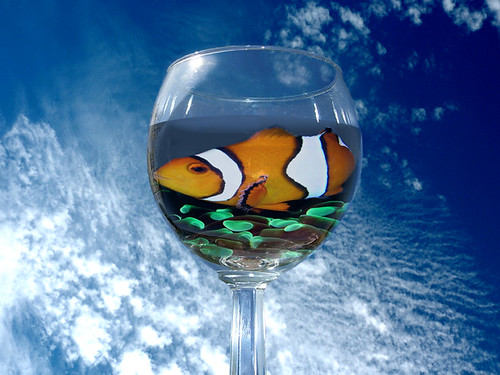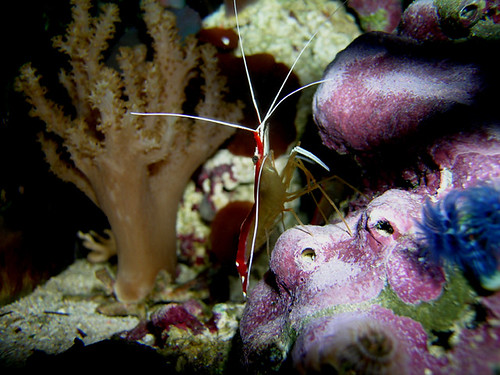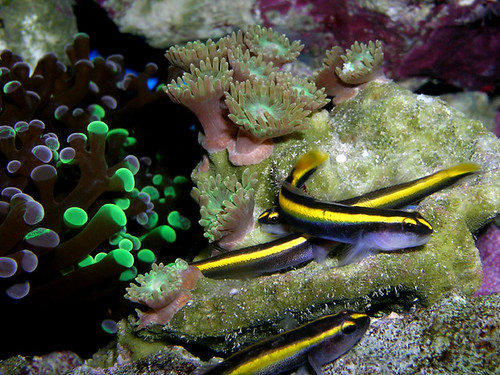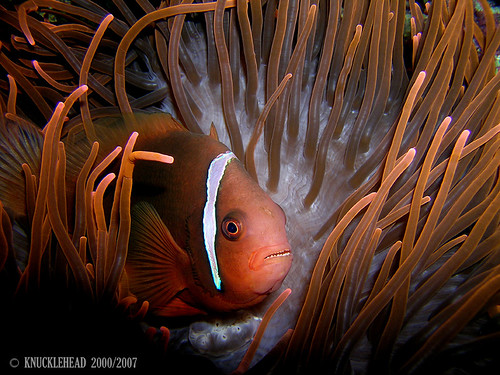
This fish a favorite with "reefers" (We`ll get back to that), because of it`s powder blue color is a docile fish, but prone to ICH a parasitic disease, & lateral line erosion. This fish is a rescued fish . It was absolutely in bad shape when I picked it up, from a vets office no less, & soon it was covered in ICH. Ich is a parasite the leaves the fish covered in little cysts that eat away at thefish & must be horrific for the poor dear. Luckily I had cleaner Gobies that ate these parasites & by chance & care, it survived. I rarely saw it for a long time except during feeding. It would venture out to eat then rush back in behind the rockwork. With gentle persuasion & a regimen of my repeated presence, this fish finally came to trust me. I then put her in a much larger tank. It is advisable & even though I do not take my own advice, any new additions should be placed in a quarantine tank for a set period of maybe three weeks & at least ten days after there is no sign of disease. The ten day period is important because that is the egg, to egg laying, time period for the ich parasite.
It is now the designated fish that comes up to where I`m sure to be attracted & does her little game to attract me. I can touch her when I feed the fish. I don`t pet the fish or anything but we can accidently touch & it does not freak out. She comfortable around me. Now to photograph this fish, I get to know how it moves & where her saftey zone is. I try & never frighten the fish in the area where it feels safe so if it does get frightened it will still go to it`s secure spot. This spot for this fish is behind the rocks, but it has different entries. Now that I`ve figured out where the fish will almost always be coming out I set up my photo plan. One must remember a few things about moving objects. First it is very difficult to focus on them. Secondly, once you do have the fish in focus, it`s invariably not there when you click the shutter. After many pictures of rocks, one must do something different. Since I know where the fish will eventually be, I focus on that spot. With this fish, you`ll notice that it is entering the open water of the reef through a cleft in the rockwork. That is it`s usual place coming from it`s safe zone. There area few vantage points from which to focus from. One is from the side & one is from the front.
In this image I`m on the side of it`s tank looking down the length of it. The next consideration is flash reflection. You cannot shoot with a flash from anywhere but with the lens against the side of the tank, IOW`s directly against the glass. Shooting images through a layer of glass, then a thick layer of water precludes one from shooting at anything more than a very shallow angle, because of the defraction , so I rarely shoot at an angle. Now the fish is getting used to the camera action & is more & more at ease. Now I can start shooting the fish from head on. Previously from the side she could not see me until she came out,& by that time I already had the shot. Now she would see me & could choose not to come out through the opening.
By clicking on the image you can browse the series of images or just watch a little slide show. You will see that there are a number of shots of this fish exiting the rocks. Now she is used to having a camera in her face & is getting used to my being in close proximity to her & peering in moving about & flashing lights in the tank. Bythis time I know where to prefocus. All the shots are taken by prefocusing. After a while you can shoot from anywhere in the tank. From the end of the tank I always prefocus on a piece of coral or a similar reference point & wait till the fish passes through that point. If I clean the inside surface of the tank, I can now take many shots with the fish reflected off the inside glass in the tank, & a double reflection from the inside of the outside of the glass thickness.
I ever mess around with buttons or knobs on the camera. I set it all for manual everything. This does include auto focus in manual mode but is not progressive or sequential focus. I pick a point, focus, keep the shutter half depressed & wait. It`s very similar to fishing.
I pretty much use my intuitive experience to change aperture & speed & will sometimes bracket some shots but not very often. There is so much movement going on that it`s counterproductive to do so. There are times that I will quit fishing & go hunting. This is when I have a special mission to shoot one fish in one tank at a specific time relative to its habits. Then I will do a few tests & adjust accordingly. If anyone thinks it`s easy, consider that there are some fish I have that I have only one acceptable shot of, & a few, none.
Last night while I was trying to show you how easy it is to confuse plants & animals in a tank, I had a nocturnal visitor. Since my door to the outside is always open, I shut the porch light off, to not attract too many night bugs. At one point something landed on my head. I knew it was fairly large but could not find it by the light from the monitor. After a while, hearing scrapings & whatever, I finally peeked in under the tray that holds the keyboard & it seems like I disturbed the BEAST .
You can see it at planet earth, & I did not add any more than that one pic of it, but have added pix of some lovely bees, one series inside a succulent flower. Tonights sunset was spectacular so I decided to take KIWI, sa small parrot & go up on the hill to shoot some panoramas. The one in the header, Y color corrected to an illogical tone so you can see that it is made up of 16 panels. These shots are taken with no tripod, just shooting & rotating my body. I overlap the shots by at least 1/3.
I download them, then create a new canvas a little less than the sum of 16 image widths & a few inches taller than one image. This one is about 50 inches long. I then copy & paste the images onto the new canvas. You can click & go see the true color one, which will change slightly before it`s done. Tomorrow I will blend the 16 panels together & show you a finished panorama. I shot 6 of them tonight & did this one in portrait format to show better what it looks like rather than 5 or 6 landscape shots.
Last night`s post was an experiment that I`ve felt horrible about all day. To show how easy it is for people to confuse what is plant or animal in our tanks, & please believe we "reefers" understand & don`t mind although we`re very quick to point it out. Most of the time any plant in a tank is a reference to unwanted algea, & we would never brag about having any. So the anemone last night was a bud from a real plant & not an animal. The fish I planted there to try & see what some one who wouldn`t know, might see the tank in his/ her eyes. I tried to see what someone else sees. I hope you`ll permit me to be sorry for it. Lest you think it malicious, please reread the post. I suggested it was sticky, & that "Reefers" spoke of it`s medicinal properties, which were discounted by scientists (hah). NDD, might have something to say, but we`ll see.
I wish you all a great day, & please remain in the shade. It was almost 100 degrees here today, so I can only imagine how dangerous it might be for the very young, the elderly & the weak in health. Keep an eye on those people.
Any mistakes in this post if any, are due to heat confusion.

































